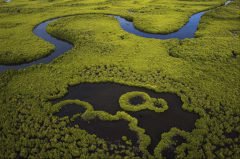
In October 2013, as part of the partnership work between the Ramsar Convention and the Danone Group, the Ramsar Convention Secretariat’s Danone Programme Management Officer Lynn Sorrentino participated in a week-long field and classroom training presented by the Livelihoods Fund, facilitated by UNIQUE Forestry and Land Use, and hosted by the NGO, YAGASU, of Indonesia.In 2008 the Danone Group created the Danone Fund for Nature, as part of an agreement with Ramsar and IUCN. As of 2011, it expanded to the Livelihoods Fund and Livelihoods Venture. The Fund works by using the carbon absorption capacity of ecosystems, such as mangrove wetlands, to finance economic development of village communities through the restoration of these key environments.
The “Monitoring a Livelihoods Project” workshop in Medan, North Sumatra, Indonesia brought together for the first time over twenty participants from around the globe. The team from Livelihoods, Jean-Pierre RENNAUD and Alice ROUAULT-REILLON, opened the first day with an overview of expectations, field work to be accomplished, and objectives for learning. The NGOs participating included YAGASU (Indonesia – our hosts), Naandi (India), Foundation Nature Environment and Wildlife Society (NEWS-India), Oceanium (Senegal), Fundaeco (Guatemala) and Pro Natura Sur (Mexico). This was more than just training, it was participatory learning, and the approach of the workshop was to build together consistent monitoring procedures for all of the projects.
You can read the article by downloading the pdf file Livelihoods Medan Report October 2013 Final.pdf or read it also on the Ramsar website
You can also read the article in French or Spanish by clicking on the language to download the pdf files!
Matthias SEEBAUER of UNIQUE Forestry and Land Use, and his colleague Prashant KADGI, facilitated the meeting so that the NGO representatives could fully understand the monitoring process, inventory, stratification, sampling design, and measurement protocol to be used intheir projects. UNIQUE is a leading carbon project developer and used a coaching approach to guide the NGO project developers to build on-the-job capacity for the Livelihoods carbon finance projects.
Day 1: Objectives of the workshop
It was important to bring together all of Livelihoods Fund’s NGO partners for a week of collaboration and learning in order to have consistent methodologies for the projects, and to address the challenges around field sampling, monitoring, measurement methods, and maintenance plans for these long-term projects. Each participant was tasked with understanding the steps involved in the monitoring process, conducting the initial steps and elaborating a clear work plan to complete their project monitoring plan. Together, the NGOs worked to establish a set of measuring methods and operative rules adapted to the Livelihoods projects. Jean-Pierre RENNAUD began the first of seven sessions on day 1 by sharing the importance of a monitoring plan. This plan is essential for each NGO partner to fulfil Livelihoods Fund’s objectives on 3 different aspects: maintaining the plantations over 20 years, getting carbon credits and generating positive results for the communities and the environment.
Measuring for Impact: Carbon Monitoring
As the day progressed, the sessions covered the steps for measuring and monitoring carbon stocks, principles and good practice of carbon monitoring, VCS AFOLU methodology requirements and each NGO project implementer shared their current status in the overall monitoring process. Before accurate measurement for carbon monitoring can occur, an inventory must happen for each project. This training session detailed the steps to perform an inventory and stratification. An inventory refers to “the complete list of plots that were finally planted by the communities at the end of all campaigns.” This inventory is a contract to state the exact boundaries and location of the project before the monitoring process can begin. An auditor hired by the Livelihoods Fund comes to check if plantations were effectively done in accordance with the contract, and determine if there are corrective measures needed. The inventory is established by the NGO and verified by an expert and all project stakeholders sign this inventory.
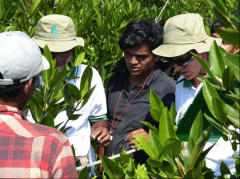
After the inventory, stratification (dividing a heterogeneous population into subpopulations (strata) based on common grouping criteria) is determined by the project implementers. Criteria related to the variables to be measured are used: in the case of the Livelihoods Projects, the criteria are carbon stocks and carbon stock change. Carbon stocks and carbon stock changes depend on physical factors (climate and soil), biological factors (tree composition as species and ages, stand density) and anthropogenic factors (management practices, disturbance history). Stratification is recommended (but not strictly required) as a tool for minimizing sampling error and to increase precision. The entire project area can be stratified into homogeneous units on the basis of the following parameters: age class of trees based on years of planting, tree species planted, stocking density of trees, aspect of hill slopes, altitude, physical and administrative boundaries, overall site quality, and potential natural risks/ disturbances.
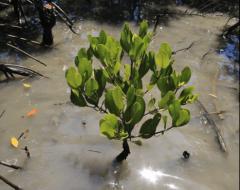
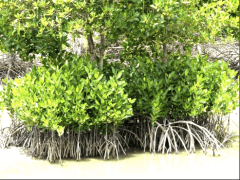
Young mangrove in Tanjung Rejo, Medan ©2013, Ramsar, L. Sorrentino / Mangroves in Tanjung Rejo, Medan ©2013, NEWS-India, D. Chatterjee
Once an inventory and stratification is completed, sampling design must take place. This was the next technical session on the first day, “Continuous and Permanent Monitoring and Sampling Design.” The scope of forest carbon monitoring is to assess changes in carbon stocks over time. For estimating those it is equally important to assess carbon densities per unit of land, which requires sampling repeated over time, so Livelihoods proposes 3-5 year intervals, so in the case of these projects, a continuous sampling design is recommended. It is good practice to use permanent plots since these are more efficient in assessing changes in carbon stocks as opposed to temporary plots where changes over time might be due to changed plot location. The NGO teams needed to understand for their projects the necessary sampling size (number of measurement plots) for accurate measurement. Larger samples are more time-consuming and expensive to measure, but the variation among plots diminishes with an increasing sample size.
Sample size is related to the variability in number of trees (stand density), in tree diameter, and variance of carbon stocks among plots. The sampling design, once finalized for the projects, will be the complete list of sample plots that will be measured during the project life. Depending on the accuracy expected for the project and the rules of Carbon Standards, several plots are randomly selected in each stratum of the stratification (around 10% of the project). This sampling design shall be the same for the whole project life and sample plots will be measured before every verification interval to evaluate the carbon removals of each stratum.
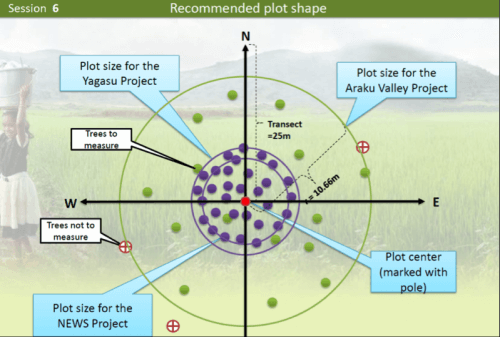
Recommended plot sizes for the varying NGO projects © Livelihoods Fund and UNIQUE Forest and Land Use presentation
Field Days 2 and 3
On days 2 and 3, measurement exercises took place at the YAGASU project area outside of Medan in the village of Tanjung Rejo, where the teams performed transect, circle and square measurement activities on plots of Rhizophora spp. and Avicennia spp. The field work allowed the participants to practice a complete monitoring process in order to measure the carbon of one project (from mapping, locating plots, to stratification, sampling, measurement, and performing the calculations). According to Matthias SEEBAUER of UNIQUE, “…circular plots are less vulnerable to errors in the plot area than square plots since the perimeter (boundary of the plot) is smaller in relation to the area and thus the number of trees on the edge is less.” How many plots needed was also part of the field work determinations by teams.
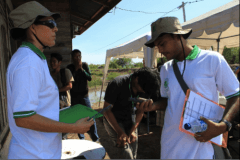
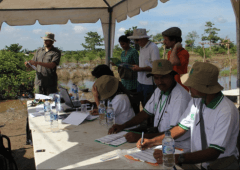
Field work preparation: How to find the plots, take the measurements and record the data. ©2013, Ramsar, L. Sorrentino
To demonstrate this practically, each group performed at least two of the types of measurement methods to understand why circular plots are preferred. An important question when trying to get an accurate view of the carbon storage potential in mangrove forests is how to measure mangroves using the DBH method: DBH – diameter at breast height (1.3m) – this is done by taking measurements of all of the major stems at DBH, and adding these numbers to get one value for the plant. Additionally, the teams collect the exact position, height, species of the mangrove, as well as other species encountered, damage to the trees, start and finish times of measurement, and the date.

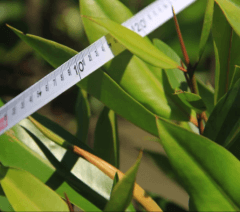
Measuring mangrove species in Tanjung Rejo, Medan
©2013, NEWS-India, D. Chatterjee and ©2013 Ramsar, L. Sorrentino
Day 4: Data Analysis: Calculating Carbon Stocks from Measurements
On day 4, the participants came back together to enter and analyze data they collected in the field. Each group presented their results, and discussed challenges and benefits of the measurement protocol. The measurements were all consistent in that they recorded time to measure trees, surface measured, density of trees, variability of measures, and generated the total carbon equivalent for each plot. The calculations modelled showed the NGOs how to measure the offset carbon of each project, as a whole. The facilitation by UNIQUE trained the NGOs on accuracy and precision in accordance with the VCS methodology defined in the monitoring plan and monitoring design. Each NGO presented their action plans for monitoring, and discussions were held on important questions such as, “What are the points which cannot be applied ‘as is’ in my project? What do we still have to work on? What are the remaining issues and how can we write a thorough project action plan?” The importance of this work was to get each NGO to finalize their plans and share ideas on how to improve their plans and identify risks. The second important theme of Day 4 was “How to maintain the plantations with the communities?” The NGOs shared their practices for community participation and involvement, and how to mitigate risks within the communities. The NGOs discussed village meetings, field checks, issues of cattle grazing, prawn seed collection, fire, and diseases/infestations. They all shared their ideas for mitigation of these risks. Several of the NGO implementers shared similar challenges, so the solution-building discussion was productive.
Day 5: Community Impact: Engaging Communities to Improve Their Livelihoods
On the last day of the workshop, YAGASU introduced the NGO participants to the wider community of Medan and Aceh – at a community centre where the direct benefits of the mangrove planting projects were shared. The NGOs wrapped up the training with overviews of lessons learned, and visited with the community members. The YAGASU team shared products made from mangrove fruits – including cookies, tea and cakes, and took time to share with the NGOs the process of making batik dyed fabrics – from dyes sourced from the mangrove trees.
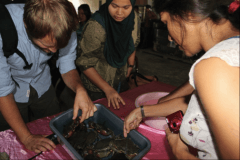

Mangrove forests provide habitats for these harvested soft shell crabs. The NGOs learned about products that generate income and livelihoods from the mangrove restoration efforts of YAGASU ©2013, Ramsar, L. Sorrentino
Through the restoration of mangrove forests, community development and economic empowerment, YAGASU staff members and community members shared with the NGOs benefits of this work, which include:
– Micro-lending for small business start-ups: women-owned art and cooking businesses, production of cookies, juices, and cakes from the mangrove plants themselves.
– Support to expand fisherman’s businesses.
– Research into the creation of all natural dyes for creation of batik fabric products for sale.
– Production of shrimp patty soup base, plans to scale up production for distribution and sale.
– Creation of a business of mangrove-wood bowls, masks and art for sale.
– Planning for an eco-resort in the area managed by community members, with food sourced locally.
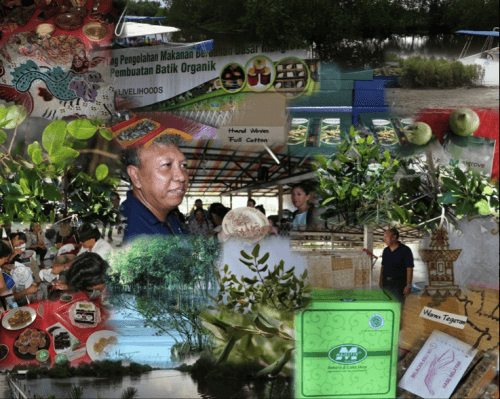
YAGASU CEO Bambang Suprayogi shared with the NGOs the different products from the mangrove forest: carved wooden plates, batik dye for fabric, mangrove cookies, crabs, shrimp ©2013 Ramsar, L. Sorrentino
Verification
The NGOs in the workshop in Medan have completed the first steps of learning planning, measurement and data analysis, and sharing with each other in order to succeed. The Livelihoods team has set up a platform for the NGOs to share results and challenges, and this platform will be important for each of the carbon monitoring projects. Over the next few months, individual preparation and platform sharing will continue to expand, and in 2014-2015, verification of every project will occur.
The Livelihoods team will engage with verification and validation experts to validate measurements and calculations done on each NGO project. The NGOs will produce a monitoring report and the experts will pre-validate the work done by the project developers. According to this first analysis, they estimate the risk of errors over the whole project and the rigorousness of our actions and then decide how many plots they want to materially check on field. The number of carbon credits given by the experts depends on the accuracy of calculations, which is linked to variability and on the non-permanence risk analysis linked to the buffer. It explains why the monitoring process is crucial in Livelihoods projects as regards both the carbon measuring process and the maintenance and corrective actions on plantations. The experts will produce a verification report to be submitted to Verified Carbon Standard (VCS) with a view to issuing the carbon credits to the investors of the Livelihoods Fund.
Next Steps
This workshop was a part of a bigger story, a story that links individuals, communities, NGOs, corporate investors, and the Livelihoods Fund together. The first chapter of the story began in 2008 with the work of Oceanium in Senegal; today the story includes projects in all four corners of the world, as seen by the NGOs present in Medan. All Livelihoods projects are widely deployed and have a significant impact in their local communities. The projects create sustainable resources for rural communities, including food security, and are implemented with NGOs and social entrepreneurs selected for their ability to carry out projects of great magnitude.
The next chapter in the story focuses again on the NGO participants, who will continue to engage with (individually and as a group) the Livelihoods Network for close monitoring of the plantations. In part they will also engage with the Ramsar Secretariat and Ramsar in their countries, and together we will share their successes and stories. In 2014, there will be another workshop and additional training for the NGOs to continue the capacity building and strengthening of the Livelihoods Network NGOs. Together the NGOs and Livelihoods will continue to produce positive results for their communities and the ecosystems they are restoring.
About the Livelihoods Fund https://livelihoods.eu
The Livelihoods Fund is an investment Fund that provides its investors (Danone, Crédit Agricole, Schneider Electric, Hermès, SAP, La Poste, Voyageurs du Monde, CDC Climat and Firmenich) with a return, albeit not a financial return per se, under the form of high-quality carbon offsets. The Fund invests in three families of projects during an investment period of 3 to 4 years, and then co-manages the projects with its local NGO partners over a period of up to 20 years. The three types of projects invested in are agroforestry, rural energy, and ecosystem restoration projects. The Fund has been operational since December 2011. There are currently six active projects in the Fund portfolio: three in mangrove restoration (Oceanium-Senegal, News-India, and YAGASU-Indonesia), two in reforestation and agroforestry (Naandi-India and Fundaeco Guatemala) and one in energy (Climate Pal-Kenya). The NGO partners of Livelihoods have planted more than 100 million trees to date. Today, these Livelihoods projects have completed almost all of the plantations, and they have learned in this workshop how to maintain and monitor the plots over the coming years. The number of plantations and the carbon sequestration potential will continue to increase, as will the value to communities, investors, and ecosystems, as the plantations mature and the area restored increases.
About the Ramsar Convention on Wetlands http://www.ramsar.org
The Convention on Wetlands of International Importance, called the Ramsar Convention, is an intergovernmental treaty that provides the framework for national action and international cooperation for the conservation and wise use of wetlands and their resources. The Ramsar Convention is the only global environmental treaty that deals with a particular ecosystem. The treaty was adopted in the Iranian city of Ramsar in 1971 and the Convention’s member countries cover all geographic regions of the planet. The Convention’s mission is “the conservation and wise use of all wetlands through local and national actions and international cooperation, as a contribution towards achieving sustainable development throughout the world”.
About UNIQUE Forestry and Land Use http://www.unique-forst.de/
UNIQUE is a land use and timber sector advisory and forest management company with headquarters in Freiburg, Germany and regional offices in Kampala, Uganda and Asunción, Paraguay. Their services include strategic advisory services, project and investment implementation support. UNIQUE is committed to the concept of sustainability with its economic, environmental and social dimensions.
About VCS: Verified Carbon Standard http://www.v-c-s.org/
VCS works hand-in-hand with public and private sector leaders all across the globe to lead a greenhouse gas reduction program that delivers massive emission reductions across the world. They achieve this by providing a trusted, robust and user-friendly program that brings quality assurance to voluntary carbon markets; pioneering innovative rules and tools that open new avenues for carbon crediting to businesses, non-profits and government entities that engage in on-the-ground climate action; and sharing knowledge and encouraging the uptake of best practice in carbon markets so that markets develop along coherent and compatible lines as top-down regulations take shape.
About YAGASU: http://www.yagasu.org/
Yagasu is an Indonesian Non-Government Organization (NGO) established on July 17, 2001 and the organization has run the first project on elephant and forest conservation beginning in October 2003. Yagasu signed an MOU with Indonesia’s national government Directorate General of Forest Protection and Nature Conservation (Ditjen PHKA), Ministry of Forestry Republic Indonesia on July 16, 2003, which was followed up by the signing Technical Agreement with Badan Lingkungan Hidup (BLH) in Aceh and BLH of North Sumatra as well as with 45 village governments and 120 local community groups in each project site. These agreements allow Yagasu to collaborate with the government bodies and local community groups to promote and support the environmental and community development through joint activities in mutually agreed project areas.
About Naandi Foundation: http://www.naandi.org
Naandi, which in Sanskrit means a new beginning; is one of the largest and fastest growing social sector organisations in India working to make poverty history. Founded in 1998 our work has 3 broad sectors: Child Rights, Safe Drinking Water and Sustainable Livelihoods. We also have a research arm that takes up action researches and other field based trials to check out innovations and their potential to positively influence policy. Naandi with a team of 300 + employees and hundreds of community workers is presently working in nine states: Andhra Pradesh, Rajasthan, Madhya Pradesh, Chhattisgarh, Orissa, Nagaland, Punjab, Haryana and Maharashtra touching the lives of more than 1million underserved people.
About NEWS: http://www.naturewildlife.org/
Nature Environment & Wildlife Society (NEWS) is a Society registered under Certificate of Registration of Societies West Bengal Act XXVI of 1961. Since 1991, NEWS is committed to protect and conserve wildlife, ecology & environment. NEWS is also committed to engage marginalized community, who are majorly dependent on the use of natural resources in and outside the protected areas, in a participatory approach in the conservation process. NEWS in its capacity also influences policy making decisions towards its committed values. Our research, conservation, projects and community development activities, are conducted by the best hands in the field and are well documented. NEWS is a member of the Indian National Committee of IUCN (World Conservation Union) and accredited to GEF.
About FUNDAECO: http://www.fundaeco.org.gt/
FUNDAECO is a private, non-political and not-for-profit organization dedicated to Nature Conservation and Sustainable Community Development. It was created in 1990, and has a history of environmental work in Guatemala and Central America. The Organization was created in order to tackle the rapid destruction and loss of Guatemala’s natural resources and biodiversity, which is trapping our country in a vicious circle of impoverishment and environmental degradation. FUNDAECO is legally accredited in the Civil Registry of Guatemala, is registered as a co-managing partner in the National Protected Areas Council (CONAP), and is a Member of the World Union for Nature (IUCN) since 1993. FUNDAECO is a Founding Member of the National Association of Environmental NGO´s (ASOREMA), and the Trinational Alliance for the Conservation of the Gulf of Honduras (TRIGOH).
About Pronatura Sur: http://www.pronatura-sur.org
Pronatura Sur is a registered non-profit organization founded in 1989 and with legal status since 1993. The organisation works closely with organisations of Pronatura in Mexico, with shared coordinated conservation actions and programs. Pronatura Sur works in the states of Chiapas, Oaxaca and Guerrero, in high priority areas of national and international conservation. Being a Civil Association, they concentrate efforts in areas where the capabilities of the organisation generate results at different scales, in local communities, strengthening actors and working groups for best results.
About Climate-Pal: https://livelihoods.eu/climate-pal.html
Climate Pal Ltd is a young Kenyan society, formed in 2011 by the Kenyan project developer Carbon Manna Africa and EcoAct, a leading French company for consulting services and voluntary carbon offsetting. Climate Pal Ltd implements development projects of improved cook stoves in rural Kenya homes. The first projects were launched in the Embu District, in order to provide a solution for sustainable cooking with local women: a modern cook stove, reducing the use of wood, creating less smoke and with a positive impact on the health of women and children. In this context, Climate Pal Ltd has partnered with Livelihoods in late 2012, to bring this innovative solution to 60,000 families in Embu District in central Kenya.
About Oceanium: http://oceaniumdakar.org/
Established in 1984 by Professor Jean-Michel Kornprobst, Oceanium is a Senegalese association aiming at environmental protection. The former president of Oceanium and renowned ecologist Haidar El Ali led the organisation for many years with a focus on three pillars: Environmental protection, Eco-tourism, and Scuba-diving. Activities extend to both onshore and offshore environments in Senegal and neighbouring countries, and are conducted by Oceanium’s team of professionals and volunteers. The association intervenes in the areas of the forest (reforestation of mangroves and other forest species and forest management), the ocean (creation of community-based Marine Protected Areas, advocacy), economic support (“green banks” combining micro credit, environmental protection and women’s entrepreneurship) and educational activities (through film screening and debate events), setup of environmental education centres, and creation of educational materials (films, posters, exhibitions, technical guide books).

